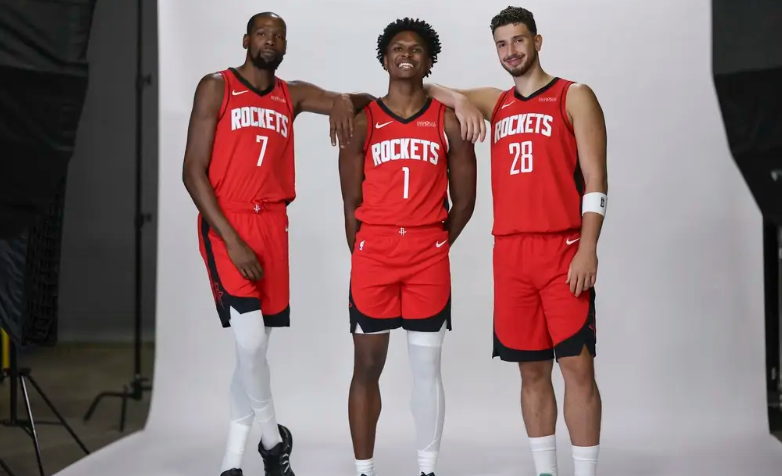
Rockets Recap: KD Joins with Championship Hopes, Van Exel Injury Raises Concerns
Last season, the Houston Rockets finally concluded a four-year rebuilding process. By the end of the regular season, they had achieved 52 wins, a significant improvement compared to previous years. More importantly, this team made it to the playoffs for the first time in the post-Harden era.
There’s no doubt that last season’s Rockets were full of potential and energy. With the so-called “Houston Seven” assembled, fans jokingly suggested that the Rockets were now capable of summoning a dragon. Head coach Ime Udoka’s ability to mold such a young team into a resilient unit has been widely recognized.
However, even within this seemingly bright blueprint, some shortcomings remained—especially when compared to the Thunder, who, using a similar team-building strategy, captured the championship last season. The contrast made the Rockets’ issues more apparent.
Although the Rockets have been recognized as one of the league’s top defensive teams over the past two years, their offensive firepower has lagged behind true title contenders. Last season, Houston ranked only 14th in the league in points per game. Additionally, all three of their shooting percentages ranked in the bottom ten, and their assists per game were the third lowest in the NBA.
Clearly, Udoka invested a lot of effort in establishing a defensive system, but his development of offensive strategies and scoring options was limited.
This problem became especially glaring in clutch moments. Data shows that last season, the Rockets averaged just 8 points in the final five minutes of close games (within five points), ranking 22nd in the league. This critical weakness contributed to their seven-game loss to the Warriors in the first round of the playoffs.
The first-round exit gave the Rockets’ management a clear view of the team’s shortcomings and a precise direction for offseason upgrades.
Shortly after the season ended, the Rockets immediately contacted Kevin Durant and, a little over a month later—before the draft—struck a trade agreement with the Suns.
Even at 37 years old, and despite being past his physical peak, Durant remained elite in clutch scoring last season, ranking 9th in the league. In other words, in games decided in the final five minutes, KD’s scoring ability remains a nightmare for almost every team in the NBA.
From Durant’s perspective, he also welcomed the opportunity to approach the final stage of his career differently. Previously, with the Nets and Suns, he often experienced a “makeshift team” feeling, hindered by teammates’ injuries and incomplete systems. Although historically an elite wing scorer, Durant had to constantly contribute as a facilitator, rim protector, and rebounder—roles outside his primary specialty. This constant distraction eventually drained his patience and contributed to his departures from both teams.
Now, with the Rockets, Durant can focus on being his natural self, concentrating on scoring from the small forward position. The Rockets’ well-structured roster will also allow him to rest strategically, preserving his peak energy for clutch moments in the final minutes of games. On paper, Durant joining the Rockets during the offseason is already a win-win scenario.
Yet Rockets management did not rest on their laurels after acquiring KD. In July, as the summer window opened, they made further moves to strengthen the roster. Under GM Rafael Stone, they signed Fini Smith and Okogie, precisely filling the void left by Dillon Brooks in the Durant trade. Capela also returned, joining Adams to support the young core, particularly Alperen Sengun, in the paint.
For existing key players, the Rockets pursued a “retain at all costs” approach. This summer, VanVleet, Adams, Jeff Green, Aaron Holiday, Tate, and others secured contract extensions. Jabari Smith Jr. received a five-year, over $100 million extension atop his rookie deal. Coach Udoka also secured a multi-million-dollar contract extension, becoming one of the highest-paid coaches in the NBA. Although the Durant trade inevitably cost the Rockets some immediate assets, like Jalen Green and Dillon Brooks, these six extensions helped maintain roster continuity and created a stable locker room environment.
However, this positive momentum was abruptly interrupted before training camp.
On September 23, during a mini-camp in the Bahamas, Fred VanVleet suffered a serious injury—an ACL tear in his right knee—effectively ruling him out for the entire next season. VanVleet had been the Rockets’ irreplaceable primary ball-handler over the past two years, with his impact particularly noticeable in critical moments. With his absence, the Rockets’ otherwise perfectly constructed roster suddenly developed a serious flaw.
The Rockets now have two options to address this gap. One is to acquire a veteran point guard from the market as an emergency replacement. The other is to promote the young guard Shepard or increase Amen Thompson’s playmaking responsibilities in the new season. Due to salary cap constraints, the team currently leans toward the latter option.
Meanwhile, Sengun’s development this summer, especially his dominant performance in the European Championship, reassured GM Stone that passing on Jalen Green in favor of building around Sengun was the correct move. However, whether Durant and Sengun can develop smooth on-court chemistry remains uncertain and will need to be tested in live games. After all, Durant has paired with many types of stars in his career but has never shared a long-term partnership with a traditional interior anchor.
This summer, the Rockets executed a series of brilliant maneuvers, holding many strong cards. With their impressive roster construction, rival executives can only watch with envy. But realistically, the Rockets are still not yet a true championship contender. That designation may only come once Durant and Sengun form a fully effective dual-core partnership and the Rockets resolve their point guard organizational issues.

